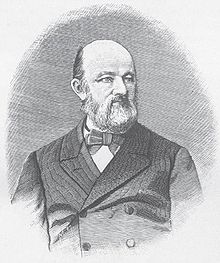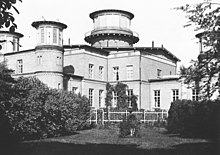Johann Friedrich Julius Schmidt



Johann Friedrich Julius Schmidt (usually JF Julius Schmidt or Julius Schmidt for short ) (born October 26, 1825 in Eutin , Kingdom of Prussia , † February 7, 1884 in Athens , Greece ) was a German astronomer and geologist .
He created and published a complete map of the moon , which was the most accurate map made in the 19th century . He also worked in the fields of zodiacal light , variable stars , comets and meteors .
As a geologist, Johann Friedrich Julius Schmidt dealt with volcanism , earthquakes and the geography of Greece .
Life
Eutin
Johann Friedrich Julius Schmidt was born in Eutin in 1825 as the son of a glazier . He was already interested in astronomical topics as a schoolboy, and his talent for drawing was noticeable. The government councilor Ernst Hellwag made it possible for him to attend the Eutin School of Academics and gave him access to a telescope .
Hamburg and Altona
He was given to relatives in Hamburg to attend grammar school . There he came into possession of the book Selenotopographische Fragmente by Johann Hieronymus Schroeter at the age of 14 . It justified his interest in the moon , which he could deepen in the Altona observatory . There he also got access to the moon map drawn up by Wilhelm Beer and Johann Heinrich von Mädler .
Johann Friedrich Julius Schmidt dropped out of school before graduating from high school and from 1842 worked at the Hamburg observatory at Millerntor with Karl Rümker . There he learned the basics of astronomy, discovered a new comet and calculated its orbit, which made the professional world aware of it.
Dusseldorf
In 1845 he became an assistant to Johann Friedrich Benzenberg at his observatory in Bilk near Düsseldorf .
Bonn
After the death of Johann Friedrich Benzenberg in 1846 he moved to the Bonn observatory to Friedrich Wilhelm August Argelander . Here he became a member of the Fridericia Bonn fraternity in 1844 . and in 1845 was a co-founder of the Frankonia fraternity in Bonn .
Olomouc
In 1853 he became head of the private observatory of Provost Ritter Eduard von Unkrechtsberg in Olomouc ( Moravia ). Through his work here he strongly influenced Gustav Tschermak's interest in geology.
Athens
In 1858 he was appointed director of the Athens Observatory , financed by the Greek banker Simon of Sina . He stayed in Athens for the rest of his life. There he made more than 70,000 variable star observations , studied comets and meteors, and discovered two supernovae .
During his observations in 1866 - supposedly - he established that the lunar crater Linnaeus had disappeared. The report on this discovery led to an intensification of lunar research, as this was seen, among other things, as an indication of geological activity of the moon. This was discussed until the middle of the 20th century ; later this false observation was attributed to the resolution limit of the telescopes available at the time for detailed observations.
In 1868 he was awarded an honorary doctorate from the University of Bonn . In 1883 Schmidt was elected to the American Academy of Arts and Sciences .
As a result of his decades of observations, Johann Friedrich published Julius Schmidt
- 1877 the moon map begun by Wilhelm Gotthelf Lohrmann and only partially published - under his name. The map contains 7100 craters.
- In 1878 he created the 25-sheet map of the Mountains of the Moon, almost two meters in diameter, on which about 33,000 lunar craters are recorded, making it the most accurate map made in the 19th century .
Johann Friedrich Julius Schmidt died suddenly in 1884 and was buried with great sympathy from the Athenians.
In 1862 he was elected a corresponding member of the Göttingen Academy of Sciences .
Publications
- Observations on Saturn and its ring in 1848 In: Astronomische Nachrichten . Altona 1848
- Results from ten years of observations on falling stars . Berlin 1852
- Observation of the total solar eclipse of July 28, 1851 at Rastenburg in East Prussia
- The zodiacal light . Brunswick 1856
- The moon . Leipzig 1856
- The eruption of Vesuvius in May 1855 . Vienna, Olomouc 1856
- About grooves on the moon . Leipzig 1866
- About fire meteors 1842 to 1867 . Vienna 1967
- Volcanic studies . Leipzig 1874.
- Studies on earthquakes . Leipzig 1875.
- About Variabilis Cygni . In: Astronomical News. Altona 1866
- (Editor): Wilhelm Gotthelf Lohrmann - Mondcharte in 25 Sections, Berlin 1877
- Map of the mountains of the moon . Berlin 1878
Others
- The moon crater Schmidt is named after Johann Friedrich Julius Schmidt (together with two other Schmidts) .
- There is a plaque in memory of Johann Friedrich Julius Schmidt on the house where he was born in Eutin.
- The written estate of Johann Friedrich Julius Schmidt is in the archive of the Berlin-Brandenburg Academy of Sciences
literature
- Death notice. In: Astronomical News . Vol. 108 (1884), Col. 129 f. ( Digitized version ).
- Konradin Ferrari d'Occhieppo : Schmidt, Johann Friedrich Julius. In: New German Biography (NDB). Volume 23, Duncker & Humblot, Berlin 2007, ISBN 978-3-428-11204-3 , p. 199 ( digitized version ).
- Siegmund Günther : Schmidt, Julius . In: Allgemeine Deutsche Biographie (ADB). Volume 31, Duncker & Humblot, Leipzig 1890, pp. 768-770.
- Gustav Peters: Astronomer Julius Schmidt . In: Blätter für Heimatkunde - Eutin . Eutin 1956, p. 65.
- Otto Rönnpag: First map of the moon by a Eutiner around 1850 . In: Jahrbuch für Heimatkunde ( Heimatverband Eutin ). Eutin 1998, pp. 40-43.
- Jürgen Vogler: A famous but forgotten son of Eutin - astronomer and geographer Julius Schmidt In: Ders .: Ostholstein yesterday: 100 stories about the country and its people. Boyens Medien, Heide 2007, p. 184 ff.
- Gudrun Wolfschmidt : Moon topography and longitude. In: Erhard Anthes, Armin Hüttermann (eds.): Tobias Mayer Symposium on the occasion of the 250th anniversary of Tobias Mayer's death (= Acta Historica Astronomiae. Volume 48). Akademische Verlagsanstalt, Leipzig 2013, pp. 161–210.
- Constantin von Wurzbach : Schmidt, Johann Friedrich Julius . In: Biographisches Lexikon des Kaiserthums Oesterreich . 30th part. Imperial and Royal Court and State Printing Office, Vienna 1875, p. 274 f. ( Digitized version ).
- Schmidt, Johann Friedrich Julius (naturalist, 18) . In: Meyers Großes Konversations-Lexikon . 6th edition. Volume 17, Bibliographisches Institut, Leipzig / Vienna 1909, p. 897 .
- Schmidt (natural scientist, poet, 14) Johann Friedrich Julius, astronomer . In: Meyers Konversations-Lexikon . 4th edition. Volume 14, Verlag des Bibliographisches Institut, Leipzig / Vienna 1885–1892, pp. 560–560. - (to life & work)
- Schmidt, Julius . In: Biographical Lexicon for Schleswig-Holstein and Lübeck . Volume 4, Neumünster 1976, p. 204.
Web links
- Information on the homepage of the Institute for Astronomy and Astrophysics in Athens
- J. Schmidt publications in the Astrophysics Data System
- Obituaries for J. Schmidt in the Astrophysics Data System
- Mentioned in "History of the Moon Maps" - The "19th Century"
Individual evidence
- ^ Franz Richarz: List of members of the Fridericia fraternity in Bonn (February 18, 1843 to autumn 1847) as well as the Arminia fraternity in Bonn (1847 to 1849) and the fraternity association Germania in Bonn (1843 to 1849). Bonn 1894, p. 15.
- ^ Directory of the old gentlemen of the Bonn fraternity "Frankonia". from September 1, 1901, p. 1.
- ↑ Mineralogy and culture in the Vienna of the Danube Monarchy - On the life and work of Gustav TSCHERMAKS (PDF; 421 kB) accessed on January 23, 2012
- ^ Members of the American Academy. Listed by election year, 1850–1899 ( PDF ). Retrieved September 24, 2015
- ↑ a b http://www.lhl.lib.mo.us/events_exhib/exhibit/exhibits/moon/p22.htm ( Memento from July 9, 2011 in the Internet Archive )
- ↑ Holger Krahnke: The members of the Academy of Sciences in Göttingen 1751-2001 (= Treatises of the Academy of Sciences in Göttingen, Philological-Historical Class. Volume 3, Vol. 246 = Treatises of the Academy of Sciences in Göttingen, Mathematical-Physical Class. Episode 3, vol. 50). Vandenhoeck & Ruprecht, Göttingen 2001, ISBN 3-525-82516-1 , p. 215.
- ↑ http://archiv.bbaw.de/archiv/archivbestaende/abteilung-nachlasse/nachlasse/schmidt_astronom
| personal data | |
|---|---|
| SURNAME | Schmidt, Johann Friedrich Julius |
| BRIEF DESCRIPTION | German astronomer and geologist |
| DATE OF BIRTH | October 26, 1825 |
| PLACE OF BIRTH | Eutin |
| DATE OF DEATH | February 7, 1884 |
| Place of death | Athens |


